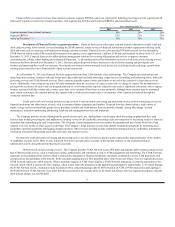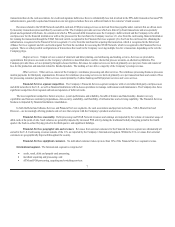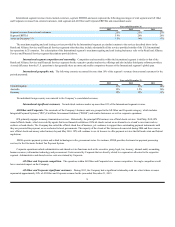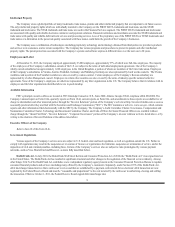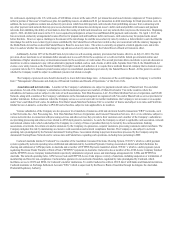First Data 2013 Annual Report Download - page 16
Download and view the complete annual report
Please find page 16 of the 2013 First Data annual report below. You can navigate through the pages in the report by either clicking on the pages listed below, or by using the keyword search tool below to find specific information within the annual report.
Company’s annual interest expense by approximately $1 million. See the discussion of the Company’s interest rate swap transactions in Note 6 to the
Company’s Consolidated Financial Statements in Item 8 of this Annual Report on Form 10-K.
The ability to adopt technology to changing industry and customer needs or trends may affect the Company’s competitiveness or demand for the
Company’s products, which may adversely affect the Company’s operating results.
Changes in technology may limit the competitiveness of and demand for the Company’s services. The Company’s businesses operate in industries that
are subject to technological advancements, developing industry standards and changing customer needs and preferences. Also, the Company’s customers
continue to adopt new technology for business and personal uses. The Company must anticipate and respond to these industry and customer changes in order
to remain competitive within the Company’s relative markets. For example, the ability to adopt technological advancements surrounding point-of-sale (“POS”)
technology available to merchants could have an impact on the Company’s International and Retail and Alliance Services business. The Company’s inability
to respond to new competitors and technological advancements could impact all of the Company’s businesses.
Material breaches in security of the Company’s systems may have a significant effect on the Company’s business.
The uninterrupted operation of the Company’s information systems and the confidentiality of the customer/consumer information that resides on such
systems are critical to the successful operations of the Company’s business. The Company has security, backup and recovery systems in place, as well as a
business continuity plan to ensure the system will not be inoperable. The Company also has what it deems sufficient security around the system to prevent
unauthorized access to the system. However, the Company’s visibility in the global payments industry may attract hackers to conduct attacks on the
Company’s systems that could compromise the security of the Company’s data. An information breach in the system and loss of confidential information
such as credit card numbers and related information could have a longer and more significant impact on the business operations than a hardware failure. The
loss of confidential information could result in losing the customers’ confidence and thus the loss of their business, as well as imposition of fines and
damages.
Changes in card association and debit network fees or products could increase costs or otherwise limit the Company’s operations.
From time to time, card associations and debit networks increase the organization and/or processing fees (known as interchange fees) that they charge. It
is possible that competitive pressures will result in the Company absorbing a portion of such increases in the future, which would increase its operating costs,
reduce its profit margin and adversely affect its business, operating results and financial condition. Furthermore, the rules and regulations of the various card
associations and networks prescribe certain capital requirements. Any increase in the capital level required would further limit the Company’s use of capital
for other purposes.
The Company depends, in part, on its merchant relationships and alliances to grow the Company’s Retail and Alliance Services business. If the
Company is unable to maintain these relationships and alliances, the Company’s business may be adversely affected.
Growth in the Company’s Retail and Alliance Services business is derived primarily from acquiring new merchant relationships, new and enhanced
product and service offerings, cross selling products and services into existing relationships, the shift of consumer spending to increased usage of electronic
forms of payment and the strength of the Company’s alliance partnerships with banks and financial institutions and other third parties. A substantial portion
of the Company’s business is conducted through “alliances” with banks and other institutions. The Company’s alliance structures take on different forms,
including consolidated subsidiaries, equity method investments and revenue sharing arrangements. Under the alliance program, the Company and a bank or
other institution form an alliance, either contractually or through a separate legal entity. Merchant contracts may be contributed to the alliance by the Company
and/or the bank or institution. The banks and other institutions generally provide card association sponsorship, clearing and settlement services. These
institutions typically act as a merchant referral source when the institution has an existing banking or other relationship. The Company provides transaction
processing and related functions. Both alliance partners may provide management, sales, marketing, and other administrative services. The alliance structure
allows the Company to be the processor for multiple financial institutions, any one of which may be selected by the merchant as their bank partner. The
Company relies on the continuing growth of its merchant relationships, alliances and other distribution channels. There can be no guarantee that this growth
will continue. The loss of merchant relationships or alliance and financial institution partners could negatively impact the Company’s business and result in a
reduction of the Company’s revenue and profit.
15



